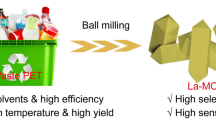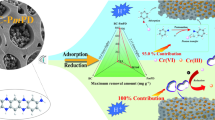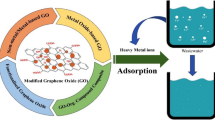Abstract
There is an urgent need to construct highly selective low-cost sensors for fast detection of toxic metal ions such as cadmium. When compared with 3D bulk materials, 2D layered materials after activation treatments show superior performances for electrochemical metal ion detection. The bulk graphitic carbon nitride (hereafter b-g-C3N4) was prepared by thermal polymerization with urea as a precursor; it was then activated through ultrasonic liquid exfoliation and protonation which resulted in successful fabrication of activated ultrathin g-C3N4 nanosheets (hereafter a-g-C3N4). The a-g-C3N4-modified glassy carbon electrode demonstrates excellent electrochemical performances for Cd2+ detection with 22.668 μA/μM sensitivity and 3.9 nM LOD (S/N = 3) due to high specific surface area and active sites created on the 2D layered structure. The chemical interference of Pb2+, Cu2+, and Hg2+ on Cd2+ detection was minimal. We have also measured Cd2+ in natural water and rice samples using the newly developed a-g-C3N4-modified electrode with high spike recoveries. Our results demonstrate the potential applications of newly developed a-g-C3N4-modified electrode for rapid detection of toxic metal ions in different sample matrixes.

The activated g-C3N4 nanosheets (a-g-C3N4) were synthesized and used to construct electrochemical sensors with high sensitivity and anti-interference performance.








Similar content being viewed by others
References
Wu Y, Pang H, Liu Y, Wang X, Yu S, Fu D, et al. Environmental remediation of heavy metal ions by novel-nanomaterials: a review. Environ Pollut. 2019;246:608–20. https://doi.org/10.1016/j.envpol.2018.12.076.
Teodoro KBR, Migliorini FL, Facure MHM, Correa DS. Conductive electrospun nanofibers containing cellulose nanowhiskers and reduced graphene oxide for the electrochemical detection of mercury(II). Carbohydr Polym. 2019;207:747–54. https://doi.org/10.1016/j.carbpol.2018.12.022.
Polykretis P, Cencetti F, Donati C, Luchinat E, Banci L. Cadmium effects on superoxide dismutase 1 in human cells revealed by NMR. Redox Biol. 2019;21:101102. https://doi.org/10.1016/j.redox.2019.101102.
Xiong R, Wu Q, Trbojevich R, Muskhelishvili L, Davis K, Bryant M, et al. Disease-related responses induced by cadmium in an in vitro human airway tissue model. Toxicol Lett. 2019;303:16–27. https://doi.org/10.1016/j.toxlet.2018.12.009.
Yang P, Zhou R, Zhang W, Yi R, Tang S, Guo L, et al. High-sensitivity determination of cadmium and lead in rice using laser-induced breakdown spectroscopy. Food Chem. 2019;272:323–8. https://doi.org/10.1016/j.foodchem.2018.07.214.
Li J, Guo S, Zhai Y, Wang E. High-sensitivity determination of lead and cadmium based on the Nafion-graphene composite film. Anal Chim Acta. 2009;649(2):196–201. https://doi.org/10.1016/j.aca.2009.07.030.
Kitte SA, Li S, Nsabimana A, Gao W, Lai J, Liu Z, et al. Stainless steel electrode for simultaneous stripping analysis of Cd(II), Pb(II), Cu(II) and Hg(II). Talanta. 2019;191:485–90. https://doi.org/10.1016/j.talanta.2018.08.066.
Zhao G, Liu G. Synthesis of a three-dimensional (BiO)2CO3@single-walled carbon nanotube nanocomposite and its application for ultrasensitive detection of trace Pb(II) and Cd(II) by incorporating Nafion. Sensors Actuators B Chem. 2019;288:71–9. https://doi.org/10.1016/j.snb.2019.02.106.
Lin C-H, Li P-H, Yang M, Ye J-J, Huang X-J. Metal replacement causing interference in stripping analysis of multiple heavy metal analytes: kinetic study on Cd(II) and Cu(II) electroanalysis via experiment and simulation. Anal Chem. 2019. https://doi.org/10.1021/acs.analchem.9b01724.
Xie Y-L, Zhao S-Q, Ye H-L, Yuan J, Song P, Hu S-Q. Graphene/CeO 2 hybrid materials for the simultaneous electrochemical detection of cadmium(II), lead(II), copper(II), and mercury(II). J Electroanal Chem. 2015;757:235–42. https://doi.org/10.1016/j.jelechem.2015.09.043.
Wu X, Wu S, Li Y, Chen H, Yuan Q, Gan W. A highly sensitive electrochemical sensor for Cd(II) based on protic salt derived nitrogen and sulfur co-doped porous carbon. Anal Chim Acta. 2019;1046:115–22. https://doi.org/10.1016/j.aca.2018.09.030.
Awual MR, Khraisheh M, Alharthi NH, Luqman M, Islam A, Rezaul Karim M, et al. Efficient detection and adsorption of cadmium(II) ions using innovative nano-composite materials. Chem Eng J. 2018;343:118–27. https://doi.org/10.1016/j.cej.2018.02.116.
Yu XY, Meng QQ, Luo T, Jia Y, Sun B, Li QX, et al. Facet-dependent electrochemical properties of Co3O4 nanocrystals toward heavy metal ions. Sci Rep. 2013;3:2886. https://doi.org/10.1038/srep02886.
Yang M, Jiang T-J, Guo Z, Liu J-H, Sun Y-F, Chen X, et al. Sensitivity and selectivity sensing cadmium(II) using amination functionalized porous SnO 2 nanowire bundles-room temperature ionic liquid nanocomposite: combined efficient cation capture with control experimental conditions. Sens Actuators B: Chem. 2017;240:887–94. https://doi.org/10.1016/j.snb.2016.09.060.
Zhang S, Liu Y, Gu P, Ma R, Wen T, Zhao G, et al. Enhanced photodegradation of toxic organic pollutants using dual-oxygen-doped porous g-C3N4: mechanism exploration from both experimental and DFT studies. Appl Catal B Environ. 2019;248:1–10. https://doi.org/10.1016/j.apcatb.2019.02.008.
Cai X, He J, Chen L, Chen K, Li Y, Zhang K, et al. A 2D-g-C3N4 nanosheet as an eco-friendly adsorbent for various environmental pollutants in water. Chemosphere. 2017;171:192–201. https://doi.org/10.1016/j.chemosphere.2016.12.073.
Shen C, Chen C, Wen T, Zhao Z, Wang X, Xu A. Superior adsorption capacity of g-C(3)N(4) for heavy metal ions from aqueous solutions. J Colloid Interface Sci. 2015;456:7–14. https://doi.org/10.1016/j.jcis.2015.06.004.
Hatamie A, Jalilian P, Rezvani E, Kakavand A, Simchi A. Fast and ultra-sensitive voltammetric detection of lead ions by two-dimensional graphitic carbon nitride (g-C3N4) nanolayers as glassy carbon electrode modifier. Measurement. 2019;134:679–87. https://doi.org/10.1016/j.measurement.2018.10.082.
Wang M, Fu R, Jin CY, Li ZL, Sun J, Yu P, et al. The facile fabrication of g-C3N4 ultrathin nanosheets with higher specific surface areas for highly sensitive detection of trace cadmium. Measurement. 2019;140:548–56. https://doi.org/10.1016/j.measurement.2019.03.067.
Xu TG, Zhang C, Shao X, Wu K, Zhu YF. Monomolecular-layer Ba5Ta4O15 nanosheets: synthesis and investigation of photocatalytic properties. Adv Funct Mater. 2006;16(12):1599–607. https://doi.org/10.1002/adfm.200500849.
Yongfu S, Hao C, Shan G, Zhihu S, Qinghua L, Qin L, et al. Freestanding tin disulfide single-layers realizing efficient visible-light water splitting. Angew Chem. 2012;51(35):8668.
Zhang YJ, Thomas A, Antonietti M, Wang XC. Activation of carbon nitride solids by protonation: morphology changes, enhanced ionic conductivity, and photoconduction experiments. J Am Chem Soc 131 (1):50-+. 2009. https://doi.org/10.1021/ja808329f.
Wang L, Xu WH, Yang R, Zhou T, Hou D, Zheng X, et al. Electrochemical and density functional theory investigation on high selectivity and sensitivity of exfoliated nano-zirconium phosphate toward lead(II). Anal Chem. 2013;85(8):3984–90. https://doi.org/10.1021/ac3037014.
Jiang T-J, Guo Z, Ma M-J, Fang L, Yang M, Li S-S, et al. Electrochemical laser induced breakdown spectroscopy for enhanced detection of Cd(II) without interference in rice on layer-by-layer assembly of graphene oxides. Electrochim Acta. 2016;216:188–95. https://doi.org/10.1016/j.electacta.2016.09.016.
Geim AK, Novoselov KS. The rise of graphene. Nat Mater 6 (3):183-191. doi:DOI. 2007. https://doi.org/10.1038/nmat1849.
Pattadar DK, Sharma JN, Mainali BP, Zamborini FP. Anodic stripping electrochemical analysis of metal nanoparticles. Curr Opin Electrochem. 2019;13:147–56. https://doi.org/10.1016/j.coelec.2018.12.006.
Dastan D, Panahi SL, Chaure NB. Characterization of titania thin films grown by dip-coating technique. J Mater Sci-Mater Electron. 2016;27(12):12291–6. https://doi.org/10.1007/s10854-016-4985-4.
Dastan D. Effect of preparation methods on the properties of titania nanoparticles: solvothermal versus sol-gel. Appl Phys A-Mater Sci Process. 2017;123(11):13. https://doi.org/10.1007/s00339-017-1309-3.
Joshi RK, Carbone P, Wang FC, Kravets VG, Su Y, Grigorieva IV, et al. Precise and ultrafast molecular sieving through graphene oxide membranes. Science. 2014;343(6172):752–4. https://doi.org/10.1126/science.1245711.
Kim HW, Yoon HW, Yoon SM, Yoo BM, Ahn BK, Cho YH, et al. Selective gas transport through few-layered graphene and graphene oxide membranes. Science. 2013;342(6154):91–5. https://doi.org/10.1126/science.1236098.
Shehzad K, Ahmad M, Xie C, Zhan D, Wang W, Li Z, et al. Mesoporous zirconia nanostructures (MZN) for adsorption of As(III) and As(V) from aqueous solutions. J Hazard Mater. 2019;373:75–84. https://doi.org/10.1016/j.jhazmat.2019.01.021.
Yang SB, Feng XL, Wang XC, Mullen K. Graphene-based carbon nitride nanosheets as efficient metal-free electrocatalysts for oxygen reduction reactions. Angew Chem Int Ed. 2011;50(23):5339–43. https://doi.org/10.1002/anie.201100170.
Yang SB, Gong YJ, Zhang JS, Zhan L, Ma LL, Fang ZY, et al. Exfoliated graphitic carbon nitride nanosheets as efficient catalysts for hydrogen evolution under visible light. Adv Mater. 2013;25(17):2452–6. https://doi.org/10.1002/adma.201204453.
Martha S, Nashim A, Parida KM. Facile synthesis of highly active g-C3N4 for efficient hydrogen production under visible light. J Mater Chem A. 2013;1(26):7816–24. https://doi.org/10.1039/c3ta10851a.
Kumar S, Baruah A, Tonda S, Kumar B, Shanker V, Sreedhar B. Cost-effective and eco-friendly synthesis of novel and stable N-doped ZnO/g-C3N4 core-shell nanoplates with excellent visible-light responsive photocatalysis. Nanoscale. 2014;6(9):4830–42. https://doi.org/10.1039/c3nr05271k.
Vinu A. Two-dimensional hexagonally-ordered mesoporous carbon nitrides with tunable pore diameter, surface area and nitrogen content. Adv Funct Mater. 2008;18(5):816–27. https://doi.org/10.1002/adfm.200700783.
Zhang J, Zhu Z, Di J, Long Y, Li W, Tu Y. A sensitive sensor for trace Hg2+ determination based on ultrathin g-C3N4 modified glassy carbon electrode. Electrochim Acta. 2015;186:192–200. https://doi.org/10.1016/j.electacta.2015.10.173.
Ting Zhanga HJ, Fanga Y, Guana JB. Detection of trace Cd2+, Pb2+ and Cu2+ ions via porous activated carbon supported palladium nanoparticles modified electrodes using SWASV.pdf. Mater Chem Phys. 2019;225:433–42. https://doi.org/10.1016/j.matchemphys.2019.01.010.
Priya T, Dhanalakshmi N, Thennarasu S, Thinakaran N. Ultra sensitive detection of Cd (II) using reduced graphene oxide/carboxymethyl cellulose/glutathione modified electrode. Carbohydr Polym. 2018;197:366–74. https://doi.org/10.1016/j.carbpol.2018.06.024.
Zhou S-F, Han X-J, Liu Y-Q. SWASV performance toward heavy metal ions based on a high-activity and simple magnetic chitosan sensing nanomaterials. J Alloys Compd. 2016;684:1–7. https://doi.org/10.1016/j.jallcom.2016.05.152.
Ma Y, Wang Y, Xie D, Gu Y, Zhu X, Zhang H, et al. Hierarchical MgFe-layered double hydroxide microsphere/graphene composite for simultaneous electrochemical determination of trace Pb(II) and Cd(II). Chem Eng J. 2018;347:953–62. https://doi.org/10.1016/j.cej.2018.04.172.
Priya T, Dhanalakshmi N, Thennarasu S, Thinakaran N. A novel voltammetric sensor for the simultaneous detection of Cd(2+) and Pb(2+) using graphene oxide/kappa-carrageenan/l-cysteine nanocomposite. Carbohydr Polym. 2018;182:199–206. https://doi.org/10.1016/j.carbpol.2017.11.017.
Liu J, Zhu G, Chen M, Ma X, Yang J. Fabrication of electrospun ZnO nanofiber-modified electrode for the determination of trace Cd(II). Sens Actuators B: Chem. 2016;234:84–91. https://doi.org/10.1016/j.snb.2016.04.073.
Wei SH, Zhao FQ, Xu ZY, Zeng BZ. Voltammetric determination of folic acid with a multi-walled carbon nanotube-modified gold electrode. Microchim Acta. 2006;152(3-4):285–90. https://doi.org/10.1007/s00604-005-0437-1.
Yu X, Mai Z, Xiao Y, Zou X. Electrochemical behavior and determination of L-tyrosine at single-walled carbon nanotubes modified glassy carbon electrode. Electroanalysis. 2008;20(11):1246–51. https://doi.org/10.1002/elan.200704179.
Hatamie A, Echresh A, Zargar B, Nur O, Willander M. Fabrication and characterization of highly-ordered zinc oxide nanorods on gold/glass electrode, and its application as a voltammetric sensor. Electrochim Acta. 2015;174:1261–7. https://doi.org/10.1016/j.electacta.2015.06.083.
Sun YF, Jian W, Li PH, Yang M, Huang XJ. Highly sensitive electrochemical detection of Pb(II) based on excellent adsorption and surface Ni(II)/Ni(III) cycle of porous flower-like NiO/rGO nanocomposite. Sens Actuator B-Chem. 2019;292:136–47. https://doi.org/10.1016/j.snb.2019.04.131.
Xiao XY, Chen SH, Li SS, Wang J, Zhou WY, Huang XJ. Synergistic catalysis of N vacancies and similar to 5 nm Au nanoparticles promoted the highly sensitive electrochemical determination of lead(ii) using an Au/N-deficient-C3N4 nanocomposite. Environ-Sci Nano. 2019;6(6):1895–908. https://doi.org/10.1039/c9en00114j.
Xu RX, Yu XY, Gao C, Liu JH, Compton RG, Huang XJ. Enhancing selectivity in stripping voltammetry by different adsorption behaviors: the use of nanostructured Mg-Al-layered double hydroxides to detect Cd(II). Analyst. 2013;138(6):1812–8. https://doi.org/10.1039/c3an36271j.
Tibbetts DF, Davis J, Compton RG. Sonoelectroanalytical detection of lead at a bare copper electrode. Fresenius J Anal Chem. 2000;368(4):412–4.
Acknowledgments
The authors acknowledge the financial support from the National Natural Science Foundation of China (Grant No. 21777164), National Basic Research Program of China (Grant No. SQ2019YFC040023), Fundamental Research Funds for the Central Universities (Grant No. PA2019GDQT0019 and PA2019GDQT0017), and Key Technologies R & D Program of Anhui Province (No. 1704c0402195). R. W. acknowledges the Program of Distinguished Professor in B&R Countries (Grant No. DL20180052).
Author information
Authors and Affiliations
Corresponding authors
Ethics declarations
Conflict of interest
The authors declare that they have no competing interests.
Additional information
Publisher’s note
Springer Nature remains neutral with regard to jurisdictional claims in published maps and institutional affiliations.
Electronic supplementary material
ESM 1
(PDF 546 kb)
Rights and permissions
About this article
Cite this article
Liu, Y., Wen, GL., Chen, X. et al. Construction of electrochemical sensing interface towards Cd(II) based on activated g-C3N4 nanosheets: considering the effects of exfoliation and protonation treatment. Anal Bioanal Chem 412, 343–353 (2020). https://doi.org/10.1007/s00216-019-02240-z
Received:
Revised:
Accepted:
Published:
Issue Date:
DOI: https://doi.org/10.1007/s00216-019-02240-z




